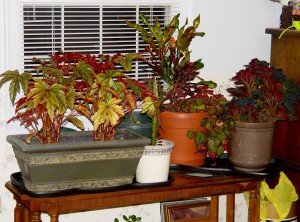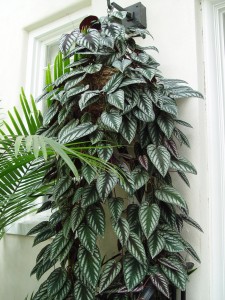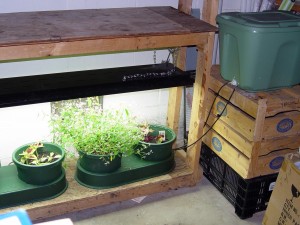The End Is Near…
October 25th, 2011
…The end of the growing season, that is.
We’re already at the point where, in an average year, we’d have had a killing frost already. But since this has been anything but an average year, who knows what’s in store for the year’s final two months?
You really should have your houseplants back inside by now. If not, go do it now. Hose them off or spray them with insecticidal soap before bringing them in so bugs don’t hitch a ride into the living room.
For the last few weeks, I’ve been taking steps to sustain tender plants I want to keep for another season.
The most basic way is to dig up and pot some of those tender specimens and turn them into winter houseplants. I’ve got plenty of them now scattered around three rooms of my house.
There’s a ‘Diamond Frost’ euphorbia , a ‘Purple Flash’ ornamental hot pepper, a ‘Vancouver’ geranium, a couple of moses-in-the-boat and ‘Black Taffeta,’ ‘Bonita Shea’ and ‘Gryphon’ begonias.
The second thing I always do is take cuttings from some of my favorite annuals and tropicals that are easy to propagate this way.
The recommended method is to snip 6-inch pieces off the tips of the mother plants, pinch off all but the top set or two of leaves, dip the bottoms in a rooting hormone and stick the cuttings in a light-weight potting mix that’s kept consistently damp.
I get almost 100 percent success without even using rooting hormone on plants such as Persian shield, coleus, perilla, iresine and Swedish ivy.
This fall my lovely wife, Sue, even managed to root a tip cutting from a beautiful shade-annual twining vine called the Rex begonia vine (Cissus discolor). This one’s hard to find in garden centers for some reason. It’s got soft, wide, lance-shaped leaves of silver, dark green and burgundy and twines up a good 6 to 8 feet in one season.
All of these were started a few weeks ago and have already rooted and started pushing out baby new leaves – a sign that the deed has been accomplished.
Now it’s just a matter of not over- or under-watering enough over winter to kill anything off.
Most of these are growing next to windows at room temperature. That’s a recipe for legginess, but that’s OK.
The goal here is to keep these plants alive, not looking their densest, in-season best. I take new cuttings from these mother plants anyway in late winter so I end up with a nice selection of transplantable-size new plants come May.
Only a few of the above get the “royal treatment” under a high-intensity grow-light system I’ve got rigged up in the basement.
I use an Autopot system from Futuregarden that consists of two self-watering trays that each hold two 10-inch pots. Each tray has a regulator in the bottom and hoses that connect to a tub of water. As the pots suck up the water, the regulators automatically draw more water from the tub. Once a week or so, I just dump water in the tub with a little fertilizer.
The trays are below a TEK light from Sun Systems that’s hooked up to a timer to make that automatic, too.
If you want to take a crack at it, here’s Futuregarden’s web site page that shows Autopots: http://futuregarden.com/hydroponics/systems_autopots.html.
Lots of online vendors carry TEK lights, and local garden centers typically carry at least one kind of grow-light system. I’d imagine all get the job done just fine. For seedlings, I use ordinary fluorescent tube fixtures.
The third plant-saving technique is collecting seeds. Keep in mind that anything that’s a hybrid isn’t likely to come back true to form, but it’s interesting to see what you DO get.
I usually save seeds of some ornamental peppers, a few heirloom tomato varieties and purple hyacinth beans. All of those usually work great and look and perform pretty close to the parent.
For more on salvaging plants from year to year, click here for a garden column I wrote a couple of years ago.










